Ethical considerations related to the exhibition Yiwarra Kuju: The Canning Stock Route
The National Museum of Australia faces the challenging task of presenting Aboriginal and Torres Strait Islander cultures to its largely non-academic audiences. This paper addresses some of the ethical issues that the Museum faced in developing the Yiwarra Kuju: The Canning Stock Route exhibition, with emphasis on the necessity to reconcile the interests and values of Indigenous Australians with the demands of museum exhibition delivery.[1]
In the past, there has been a tendency to fully translate the ‘cultural’ voice into the ‘museum’ voice. As museological philosophies have changed, there is now greater focus on presenting the first voice – the voices of those who have experience of the cultural or historical events being described.
Despite this growing desire for the Museum to allow subjects to ‘speak’, however, there is still a demand for the museum to intervene, moderate and translate experience into something audiences can understand. Yiwarra Kuju is an ideal case study by which to examine how culturally disparate partners can work together to satisfy these competing interests.
In July 2010 the Museum, in collaboration with FORM[2] – a not-for-profit arts organisation based in Western Australia – and nine Western Australian art centres, opened Yiwarra Kuju: The Canning Stock Route at the National Museum in Canberra.[3] The exhibition was on display at the Museum for six months, during which it was viewed by more than 122,000 visitors, making it the Museum’s most successful exhibition since its opening in 2001.[4]
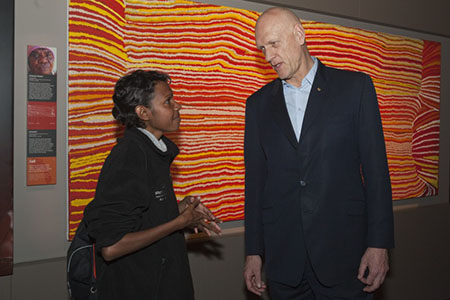
photograph by George Serras
National Museum of Australia
The attendance figures are particularly impressive when considered in light of the high profile debate about Indigenous issues in the Australian media. Australian audiences receive considerable – often negative – exposure to Aboriginal and Torres Strait Islander social issues, politics, art and culture. Additionally, Indigenous cultural imagery has become a frequent backdrop to our daily lives, appearing (usually without explanation or context) on clothing, jewellery, books, aircraft, and as visual backdrops to political and business media.
There is, therefore, always the risk in exhibiting Australian Indigenous cultures that over-exposure on a day-to-day basis has led to ‘dot and line fatigue’ – a reference to the two most popular Indigenous Australian art styles: the dot paintings of the desert and the cross-hatched art of Arnhem Land. This could deter audiences who may perceive themselves to be already adequately familiar with the visual characteristics of the work on display. Indeed, one museum that was approached to host Yiwarra Kuju informally advised that the exhibition would not attract audiences sufficient to warrant its display in its larger temporary gallery.
Delightfully, however, the success of the exhibition quickly put paid to any such apprehension. There was not only a steady stream of visitors to the exhibition, but also enthusiastic engagement with the public programs associated with it, including lectures, tours, festivals, performances and related online material. The audiences clearly wanted to engage with Indigenous Australian culture beyond the level of an art display. Text panels were read with great interest and parents were observed explaining to their children what was being communicated through the art, the wall text and the multimedia installations. The audience interrogation of the multimedia displays went beyond their novelty value. Audiences were not just seeking visual entertainment, but also sought to understand the culture and histories of the artists that were represented in this exhibition.
What was the reason for this successful engagement? It certainly owed a lot to a sympathetic design and contemporary, engaging, multimedia. More importantly, however, the exhibition had a ‘life’ of its own that, I propose, emerged from the ethics of primary research and exhibition development – in particular, recognition of the right of Aboriginal Australian stakeholders to be kept informed of the exhibition development process and, in the exhibition strategy, for their voices to be heard first, before the interpretation of curators and other contributors.
Nonetheless, the exhibition was still an engagement between at least three major stakeholder groups with very different interests and expectations. These interests had to be reconciled and this was an outcome that simultaneously required negotiation and compromise. For the purpose of this paper, I have ranked the progression of interests from local, to state, to national.
First, there were the Indigenous Australian art centres and artists working with FORM in arts development within the communities that they represent and in whose welfare they are, naturally and admirably, primarily interested. They confront community concerns on a day-to-day basis and they work hard to generate resources to support their artists. Representation, for them, provides an opportunity to reach bigger markets and to raise the profile of local artists.
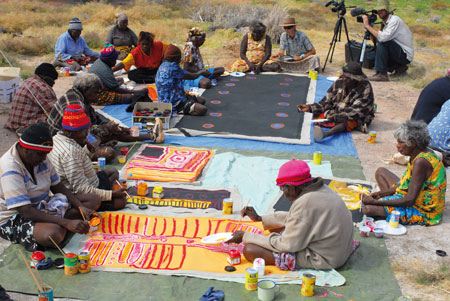
photograph by Tim Acker, 2007
Secondly, there were the interests and expectations of FORM. As a not-for-profit cultural organisation, FORM advocates creative opportunities for artists in Western Australia. FORM initiated the Canning Stock Route Project – the research from which Yiwarra Kuju was one outcome. Working with nine art centres, FORM invested considerable resources into research and consultation with artists and art centres and encouraged the creation of works representing the Aboriginal histories of the Canning Stock Route. Their stakeholders were the hundreds of Aboriginal artists and families spread across the north-west of Western Australia. In addition, there were FORM’s relationships with state business and political interests that had to be cultivated and maintained. FORM’s focus, therefore, was on the combined good of the art centres, artists and Western Australia.
Thirdly, at the other end of the scale, was the National Museum of Australia. As a social history museum with a range of agendas targeting a variety of audiences and interests, it wouldn’t be unreasonable to claim that, at any one time, the Museum has more than 100 projects at different stages of development – ranging from getting the books to balance, to arranging a school visit, to developing and maintaining a website, to exhibitions. At the corporate level, no single project takes precedence and, in order to fulfil its mission, the Museum must necessarily implement processes and protocols that do not always accommodate the flexibility required in dealing with large groups of stakeholders.
So, there were three very different partners in this exhibition.
The origins of the exhibition
In 2007, the FORM team approached the Museum with a proposal for a temporary exhibition stemming from the Canning Stock Route Project, which was already underway. In researching the project, FORM staff accompanied artists from the nine art centres in travelling the length of the Canning Stock Route, encouraging the artists to paint and, at the same time, documenting their cultures, histories and personal stories. FORM described the project as comprising ‘contemporary art, oral history, photography, film and interactive multimedia, a touring exhibition and a professional development program’.[5]
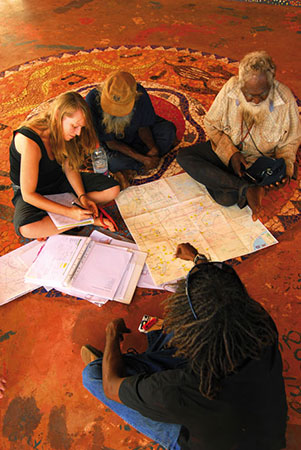
photograph by Tim Acker, 2009
In line with FORM’s role of stimulating arts and culture in Western Australia, the project’s aims were to:
record and share the vibrancy of desert life today, connect Aboriginal creativity and history with new audiences, enhance the skills of Aboriginal professionals and create new, cross-cultural, multidisciplinary channels for collaboration between remote and urban.[6]
The exhibition that FORM originally proposed to the Museum reflected the organisation’s experience in a style of presentation of Indigenous Australian art that sits more comfortably within visual art galleries than museums. In the discussions that followed, however, the Museum was encouraged by the proposal’s evidence of close engagement with, and by, Aboriginal people; the volume of supporting material; and, the relatively small budget required to mount the exhibition.
The Museum was interested in the cultural and historical information that accompanied the artworks, which supported its mission as a history museum to provide content regarding the associated histories and cultures of the artists and communities involved in the project. Ultimately, the Museum chose to become partners in the exhibition and to acquire the collection of 126 works and accompanying documentation that had been produced by the project.
This was an unusual partnership for the Museum in that it was based on equitable collaborations and contributions. While the Museum’s partnerships are typically with other museums, working together on content development or displaying an exhibition prepared by another institution, or with financial benefactors, this partnership demanded that each party was equally necessary to the effective development and delivery of the exhibition through a combination of unique skills, knowledge, and experience.
In this case, each partner represented different stakeholder interests, experiences and expectations. The development of the partnership required a delicate balance between the ethics of respectful representation of the cultures and values of the Aboriginal Australian contributors against the demands for delivery.
Museums typically deliver their products to audiences drawn from within their own culture, with whom they communicate by way of established cultural patterns and traditions. The communication systems of another culture may not necessarily synchronise with those of a museum’s primary audience. As curators in the field of Indigenous Australian cultures, we attempt to make those cultures understandable to our audiences. In so doing, we often have to moderate, mediate, and translate those cultures into ‘our language’ – the language of our audiences. Sometimes the stories are told in a way that they would not have been told by Indigenous Australian sources: in communicating with our audiences, we tend to simplify, to compromise.
Because of the range of partners and stakeholders involved in the Yiwarra Kuju exhibition, and because of a shift in museological philosophy and practice to more fully explore and exploit the use of the ‘first voice’, the development process gave precedence to representing histories and stories from the Aboriginal Australian perspective. All stakeholders wanted to bring the usually unseen aspects of exhibition development to the surface and FORM and the art centres wanted to profile the project from which the exhibition was drawn, in particular the fieldwork and consultation process.
This ambition coincided with the Museum’s developing philosophy of ethical engagement with communities. Indigenous Australian people must be informed about our work and exhibitions and other content should not be developed in isolation from the peoples they purport to portray. Further, greater emphasis is to be given to the Indigenous voice as ‘first voice’.
The Museum has a long tradition of ensuring that groups are not just informed about its plans and exhibitions, but also have direct input into content. This is an expensive mission and budgets increase proportionately with the scale of each exhibition. Yiwarra Kuju took up 800 square metres of floor space, which involved an unprecedented number of objects, elements, stories, and people to consult with. Consultation to the minimum acceptable standard is a major logistical exercise in itself and the costs are considerable, often due to the remoteness of locations in which stakeholders are based (distances are often measured in thousands of kilometres) and to the time necessary to ensure that cross-cultural communication is of high quality.
It was clear in early discussions that FORM had worked closely with the artists and their families in the activities that led to the creation of the works and the collection of associated documentation. This engagement was not consultation about the content of the exhibition, however, but wider research that collected a mass of information from which the exhibition was to emerge. The FORM team also included dedicated cultural advisors and trainee Indigenous Australian curators and filmmakers. From its outset, the project was a creative and collaborative endeavour, rather than responsive, and FORM must be acknowledged for this initial high level of ethical engagement with the artists, which ultimately aligned with the aspirations and practice of the Museum.
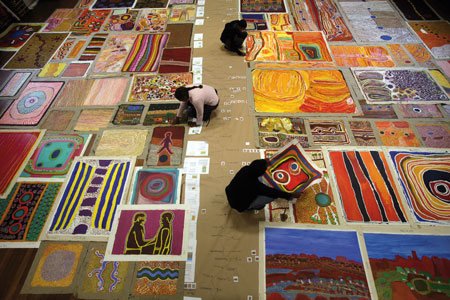
photograph by Ross Swanborough, 2008
Once the Museum became a partner in mounting the exhibition, management of content was assigned to the Aboriginal and Torres Strait Islander program. As head of the program at the time, I had the role of coordinating senior curator. The wider Museum project team included participants from exhibitions, conservation, registration, publishing, public programs, multimedia and legal teams. All members were experienced and sympathetic to the representation of Indigenous Australian cultures through exhibitions, and their contribution was, of course, critical to the success of the exhibition.
The FORM team continued to refine the collection at various locations in Perth, which was where the exhibition content started to take shape. The issue of what to include in the exhibition raised multiple questions. What determines whether an artwork or object will be used in an exhibition of Indigenous Australian art? Is the selection of works based on an Indigenous Australian or Western idea of quality, aesthetics and cultural significance? Who should judge what is ‘good’ or ‘bad’? In this case the process appeared balanced, especially with the involvement of the emerging Aboriginal Australian curators who assisted in the selection of works in their capacity as cultural advisors as well as curatorial trainees.
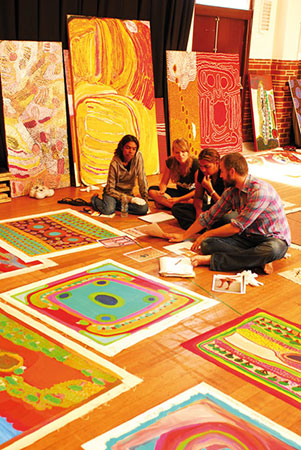
photograph by Tim Acker, 2009
As the exhibition planning progressed, FORM continued to inform and consult with the artists and the art centres through visits and correspondence. Regular fieldtrips were undertaken to obtain approvals and discuss issues, and close attention was paid to the issues of copyright and reproduction. Topics that might be thought of as relatively mundane took on new importance in light of the need to appropriately recognise the rights of Indigenous Australian artists. What images could be reproduced for marketing or merchandise? What could be used on the web? Could images be cropped? If the artist died, could his or her work still be shown? Who would inherit rights to speak for the work in the event of an artist’s death?
This attention to detail in consultations characterised FORM’s work and, at the same time, satisfied the Museum that best practice ethical behaviour was being followed and that the exhibition was an endeavour worthy of continued support. Artists, families and art centres were kept informed of activities throughout the exhibition development and they were given the opportunity to comment on the proposed content.
In terms of the practicalities of mounting the exhibition, the Museum has established processes for progressing the development of large exhibitions. This structure complicated the Museum’s relationship with its external stakeholders, who were unfamiliar with these processes and the necessary restrictions that they entailed. Efforts to ensure that artists’ rights were protected resulted in the creation of complicated legal agreements that were, sometimes, contradictory. Contracts and formal agreements were made between FORM and the art centres, between FORM and the Museum, and between FORM, the art centres and the Museum regarding copyright. While the process was complex and confusing, the outcomes were ultimately achieved.
The team from FORM was also unfamiliar with the way in which the Museum manages exhibition text and the constraints that are applied in light of the exhibition design and budget. Text overruns were negotiated with consideration for distinguishing the curator’s voice and ensuring objective curatorial reporting. Aboriginal Australian people tell us what they believe to be true. Curatorial research may contradict those beliefs. If we present the Indigenous voice without ancillary explanatory text in the curator’s voice, such disjunctions can be avoided. Occasionally, however, the curator must intervene to clarify a point or provide background and, in those cases, the contradiction can be explicit. The ambition to use only the first voice is based on a desire for audiences to hear the experiences, and learn of cultural beliefs and practices, from those who directly experienced them. This results in a move away from opening passages such as ‘Aboriginal people believe …’, to the stronger, personal expression of ‘I believe …’
Nonetheless, the Museum has to mediate so that the message reaches the target audience. Some cultural context and meaning is always lost in translation – the Museum’s task is to avoid distortion and to ensure that the translation remains true to what is said – in spirit if not in exact meaning. Yiwarra Kuju is based on first voice –in media and in graphics – but many quotes had to be cut down from their original length. After curators and editors worked to ensure that the essential message was retained, all the content was approved by the artists and informants.
Over time, and as a result of close engagement with the partners and stakeholders and communication between team members, the difficulties of mounting such a complex exhibition were resolved. The teething problems faced, however, provided a useful lesson in highlighting the gulf that exists between Indigenous Australian and corporate cultures.
Budget constraints were the most significant obstacle to ensuring that ethical behaviour in the research and delivery of the exhibition was maintained. At the first meeting of the consolidated exhibition curatorial team in Perth, my first advice to FORM was that I was the person who would be refusing their requests on the basis, primarily, of financial limitations. Over three years, the Museum and FORM made a significant financial contribution to the development of Yiwarra Kuju. While the exhibition was, theoretically, delivered on budget, the cost of ensuring appropriate stakeholder engagement was considerable. Being ethical costs money.
Still, at the end, the exhibition was a success. Yiwarra Kuju was a career highlight for me – not just because it was so well-received, but because I felt it was ‘done right’. The extensive consultation and research on which the exhibition was based – from its earliest inception through to its closing days at the Museum, was fundamental to the ethics of the project. Many of the artists were present at the opening and on festival days, emerging Indigenous Australian curators and filmmakers attended the Museum on a number of occasions for exhibition work and professional development. This Indigenous participation brought the exhibition to life.
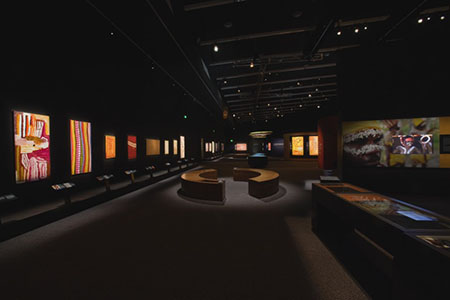
photograph by Jason McCarthy
National Museum of Australia
Because curatorial projects are ‘business as usual’ in a Museum context, we often fail to articulate our processes to external audiences – both public and professional. Moving quickly onto our next project, we don’t reflect on the process and consider not only what went right and what went wrong but also what was right and what was wrong. The ethical attributes of the exhibition are important, and ethical practice contributes its own ambience to exhibitions.
The ethical calibre of this project owes much to its being a collaboration, not only of resources, but also of intentions. The partnership brought in extra resources, both personal and financial, including FORM’s initial research and consultations, the willingness of art centres to participate by bearing day-to-day costs and acting as communication hubs, and the Museum’s financial contribution and expertise. I doubt that any one partner could have delivered the exhibition on the same scale with the same level of engagement with artists. Hopefully we can sustain this level of ethical engagement based on the principal of the ‘right of representation’ into the future – it is worth it.
Endnotes
1 This paper is based on a talk presented at Museums Australia’s national symposium, Memory & Ethics (19–20 May 2011, Canberra). It has benefited greatly from comments by Ann Robb (National Film and Sound Archive), Stephanie Bull (National Museum of Australia) and Fiona Dalton (National Museum of Australia). Thanks also to Justine Molony for her careful editing.
2 www.form.net.au/, accessed 24 July 2014.
3 www.nma.gov.au/exhibitions/yiwarra_kuju/home, accessed 24 July 2014.
4 The exhibition was subsequently chosen by the Australian Government for display at the 2011 Commonwealth Heads of Government Meeting (CHOGM) in Perth. The exhibition was open to the public at the Perth Exhibition and Convention Centre, 2–27 November 2015, and at the Australian Museum, Sydney, 17 December 2011 – 29 April 2012. In 2014 a banner package of the exhibition was developed for display in Australia’s embassies and high commissions. Embassies in 14 different countries displayed the banner exhibition in the 2014–15 financial year. A smaller exhibition drawing on the Canning Stock Route collection, Kaninjaku: Stories from the Canning Stock Route, opened at the National Museum of Australia in August 2015.
5 www.form.net.au/project/one-road-mira-canning-stock-route-project/, accessed 18 February 2013.
6 www.form.net.au/project/one-road-mira-canning-stock-route-project/, accessed 18 February 2013.
